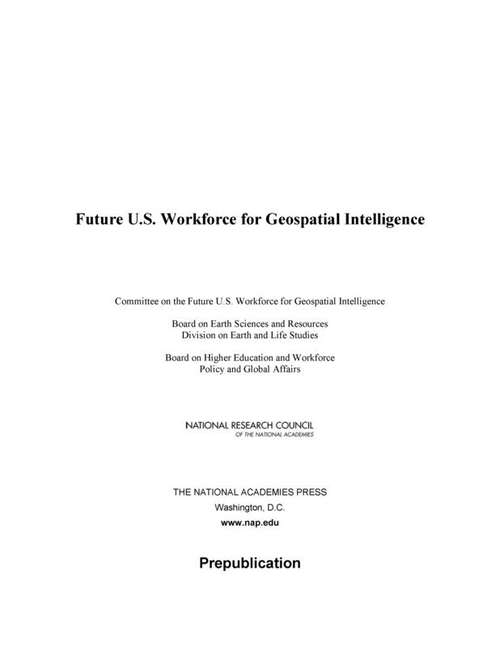Future U.S. Workforce for Geospatial Intelligence
By:
Sign Up Now!
Already a Member? Log In
You must be logged into Bookshare to access this title.
Learn about membership options,
or view our freely available titles.
- Synopsis
-
We live in a changing world with multiple and evolving threats to national security, including terrorism, asymmetrical warfare (conflicts between agents with different military powers or tactics), and social unrest. Visually depicting and assessing these threats using imagery and other geographically referenced information is the mission of the National Geospatial-Intelligence Agency (NGA). As the nature of the threat evolves, so do the tools, knowledge, and skills needed to respond. Technological advances are moving geospatial tools and near-real-time information products into the hands of warfighters, emergency responders, and other users. New geospatial themes and interdisciplinary approaches to problem solving that could potentially improve geospatial intelligence (GEOINT) are emerging in university curricula. In addition, a new generation of students accustomed to working in flexible, socially connected, and highly integrated technological environments is bringing new capabilities into the workplace.
The challenge for NGA is to maintain a workforce that can deal with evolving threats to national security, ongoing scientific and technological advances, and changing skills and expectations of workers. The agency’s success depends in part on the availability of experts with suitable knowledge and skills. At the request of H. Greg Smith, NGA chief scientist, the National Research Council (NRC) established a committee to assess the supply of expertise in geospatial intelligence fields, identify gaps in expertise relative to NGA’s needs, and suggest ways to ensure an adequate supply of geospatial intelligence expertise over the next 20 years.
This report analyzes the geospatial intelligence workforce in 10 areas defined in New Research Directions for the National-Geospatial Intelligence Agency: Workshop Report (NRC, 2010a), including 5 core areas (geodesy and geophysics, photogrammetry, remote sensing, cartographic science, geographic information systems [GIS] and geospatial analysis) and 5 emerging areas (GEOINT fusion, crowdsourcing, human geography, visual analytics, and forecasting). The availability of expertise in these areas was assessed using education and labor statistics collected from government sources. Gaps in expertise relative to NGA’s needs were identified by comparing the statistics to information on NGA’s current scientist and analyst positions and published assessments of demand for geospatial occupations. Ideas for building the necessary knowledge and skills were chosen based on a review of training programs in universities, professional societies, government agencies, and private companies.
- Copyright:
- 2013
Book Details
- Book Quality:
- Publisher Quality
- ISBN-13:
- 9780309268646
- Related ISBNs:
- 9780309268653
- Publisher:
- The National Academies Press
- Date of Addition:
- 12/13/18
- Copyrighted By:
- the National Academy of Sciences
- Adult content:
- No
- Language:
- English
- Has Image Descriptions:
- No
- Categories:
- Nonfiction, Science
- Submitted By:
- Bookshare Staff
- Usage Restrictions:
- This is a copyrighted book.
